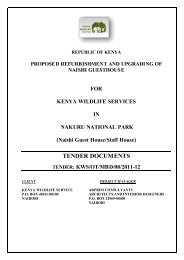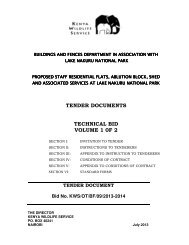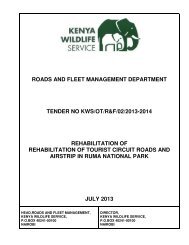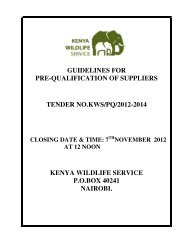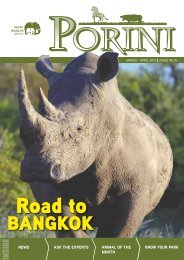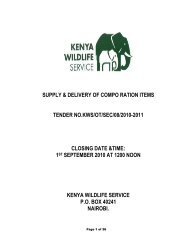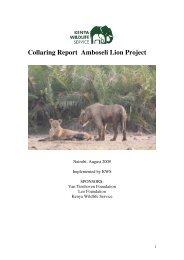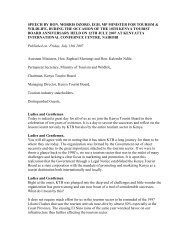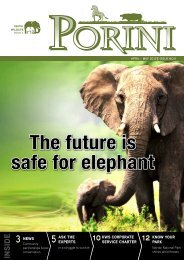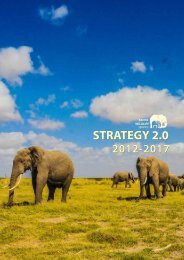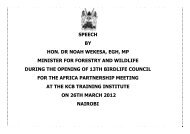Conservation and Management Strategy for the Elephant in Kenya
Conservation and Management Strategy for the Elephant in Kenya
Conservation and Management Strategy for the Elephant in Kenya
You also want an ePaper? Increase the reach of your titles
YUMPU automatically turns print PDFs into web optimized ePapers that Google loves.
CONSERVATION AND MANAGEMENT STRATEGY FOR THE ELEPHANT IN KENYA 29<br />
2.1.2.3 Ecology <strong>and</strong> Socio-economics<br />
<strong>Elephant</strong>s are critical to susta<strong>in</strong><strong>in</strong>g a functional ecosystem <strong>in</strong> <strong>the</strong><br />
dryl<strong>and</strong>s of <strong>Kenya</strong> <strong>and</strong> are an essential draw <strong>for</strong> tourism.<br />
The importance of elephants <strong>in</strong> susta<strong>in</strong><strong>in</strong>g <strong>the</strong> functionality of<br />
<strong>the</strong>se ecosystems cannot be understated, <strong>and</strong> <strong>the</strong> decl<strong>in</strong>e of<br />
elephants <strong>in</strong> <strong>the</strong> latter half of <strong>the</strong> 20th century has seen a major<br />
shift <strong>in</strong> vegetation from grassl<strong>and</strong> to bushl<strong>and</strong> <strong>and</strong> scrubl<strong>and</strong> <strong>in</strong><br />
much of <strong>the</strong>ir <strong>for</strong>mer range. This has led to a decl<strong>in</strong>e <strong>in</strong> livestock<br />
numbers <strong>and</strong> <strong>in</strong>creased poverty as a result of poor livestock returns.<br />
The natural, renewable resource-based, economy of <strong>the</strong> rangel<strong>and</strong>s<br />
is undervalued <strong>in</strong> <strong>the</strong> national statistics, <strong>and</strong> <strong>the</strong> communities have<br />
largely been marg<strong>in</strong>alised politically <strong>and</strong> rema<strong>in</strong> outside ma<strong>in</strong>stream<br />
development, particularly <strong>in</strong> education <strong>and</strong> health care. S<strong>in</strong>ce<br />
limate change has emerged as a major threat to biodiversity <strong>and</strong><br />
<strong>in</strong>tensive livestock systems are considered a contributory factor to<br />
this, open nomadic rangel<strong>and</strong> is be<strong>in</strong>g considered as a more<br />
susta<strong>in</strong>able production system with lower impacts. This will provide<br />
<strong>in</strong>centives <strong>in</strong> future <strong>for</strong> conserv<strong>in</strong>g <strong>the</strong>se ecosystems.<br />
[ TOP ] Plate 25.<br />
Group of elephants <strong>in</strong> <strong>the</strong> Tsavo ecosystem<br />
– Charles Ooro, <strong>Kenya</strong> Wildlife Service<br />
<strong>Elephant</strong>s through <strong>the</strong>ir cyclical stimulus assist woody plant regeneration, through heavy brows<strong>in</strong>g. They promote<br />
seed dispersal through dung - essential <strong>for</strong> ma<strong>in</strong>ta<strong>in</strong><strong>in</strong>g <strong>for</strong>est plant diversity. Seeds of some tree species are<br />
dependent on elephant digestion <strong>for</strong> germ<strong>in</strong>ation. Thus <strong>the</strong> expansion of elephant distribution, especially <strong>in</strong> <strong>the</strong><br />
nor<strong>the</strong>rn rangel<strong>and</strong>s, will provide important opportunities <strong>for</strong> simultaneously conserv<strong>in</strong>g biodiversity <strong>and</strong> reduc<strong>in</strong>g<br />
vulnerability to ecosystem degradation. The contribution of elephants to achiev<strong>in</strong>g overarch<strong>in</strong>g national biodiversity<br />
conservation objectives can be considerable. <strong>Kenya</strong> is a leader <strong>in</strong> tourism <strong>in</strong> Africa <strong>and</strong> its presence is often quoted<br />
as <strong>the</strong> saviour of wildlife but <strong>the</strong> true facts are that this economic sector fails to fully translate <strong>the</strong> potential<br />
socioeconomic benefits <strong>and</strong> share <strong>the</strong>m equitably, <strong>and</strong> this is a concern. It is ironic that <strong>the</strong> poorest communities <strong>in</strong><br />
<strong>Kenya</strong> are those liv<strong>in</strong>g with wildlife when <strong>the</strong> contribution of tourism to GDP <strong>in</strong> <strong>the</strong> country is so large (63%)<br />
amount<strong>in</strong>g to approximately 60 billion ksh a year <strong>and</strong> provid<strong>in</strong>g <strong>the</strong> bulk of <strong>the</strong> country’s <strong>for</strong>eign exchange. Local<br />
communities that co-exist with elephants are <strong>for</strong>ced to seek livelihoods based ma<strong>in</strong>ly on livestock <strong>and</strong> subsistence<br />
agriculture, or to poach <strong>the</strong> animals as a source of supplementary prote<strong>in</strong> or cash through sale of products. The<br />
centralisation of tourism revenue <strong>and</strong> <strong>the</strong> scramble <strong>for</strong> locations <strong>for</strong> lodges <strong>in</strong> key sites, like <strong>in</strong> Samburu, Amboseli<br />
<strong>and</strong> Mara, <strong>in</strong>creases pressure on elephants, reduc<strong>in</strong>g availability to key <strong>for</strong>age <strong>and</strong> water resources, <strong>for</strong>c<strong>in</strong>g <strong>the</strong>m<br />
to use marg<strong>in</strong>al resources <strong>and</strong> <strong>in</strong>creas<strong>in</strong>g conflict with local people. Although this is caus<strong>in</strong>g considerable difficulty<br />
<strong>for</strong> <strong>and</strong> pressure on <strong>the</strong> local <strong>and</strong> central government to resolve HEC, it is <strong>the</strong> poverty issue that is most threaten<strong>in</strong>g<br />
especially <strong>in</strong> remote areas where hi<strong>the</strong>rto human society had rema<strong>in</strong>ed remarkably tolerant of elephant. Most of <strong>the</strong><br />
extirpations were a result of organised poach<strong>in</strong>g gangs from distant communities, often f<strong>in</strong>anced from urban centres<br />
<strong>and</strong> through <strong>in</strong>ternational traders. Rural people appreciate <strong>the</strong> ecological function of elephants <strong>and</strong> appraisal has<br />
shown that many pastoralists regret <strong>the</strong> decl<strong>in</strong>e <strong>in</strong> elephants that <strong>the</strong>y observe annually, which is result<strong>in</strong>g <strong>in</strong><br />
decl<strong>in</strong><strong>in</strong>g pastures from encroachment of bushl<strong>and</strong>.<br />
In response to <strong>the</strong> desire <strong>for</strong> better <strong>in</strong>tegration of communities liv<strong>in</strong>g with wildlife <strong>in</strong> <strong>the</strong> tourism economy, <strong>Kenya</strong>ns<br />
have developed novel community-based ecotourism <strong>in</strong>itiatives, many <strong>in</strong> elephant ranges outside national parks<br />
<strong>and</strong> reserves <strong>and</strong> this phenomenon is exp<strong>and</strong><strong>in</strong>g. Cont<strong>in</strong>ued development of this sector at a sophisticated level<br />
with<strong>in</strong> unfenced ecosystems, provides tourists with opportunities that are culturally <strong>in</strong>terest<strong>in</strong>g as well as provid<strong>in</strong>g<br />
spectacular scenery <strong>and</strong> wildlife - giv<strong>in</strong>g <strong>Kenya</strong> a competitive edge over o<strong>the</strong>r major tourism dest<strong>in</strong>ations. A strategy<br />
which will provide <strong>the</strong> basis <strong>for</strong> elephant expansion <strong>in</strong>to historical range will give fur<strong>the</strong>r impetus to ecotourism<br />
development <strong>and</strong> br<strong>in</strong>g more remote <strong>and</strong> poverty-stricken communities <strong>in</strong>to tourism management, provid<strong>in</strong>g<br />
opportunities <strong>for</strong> improv<strong>in</strong>g <strong>the</strong>ir livelihoods susta<strong>in</strong>ably.



